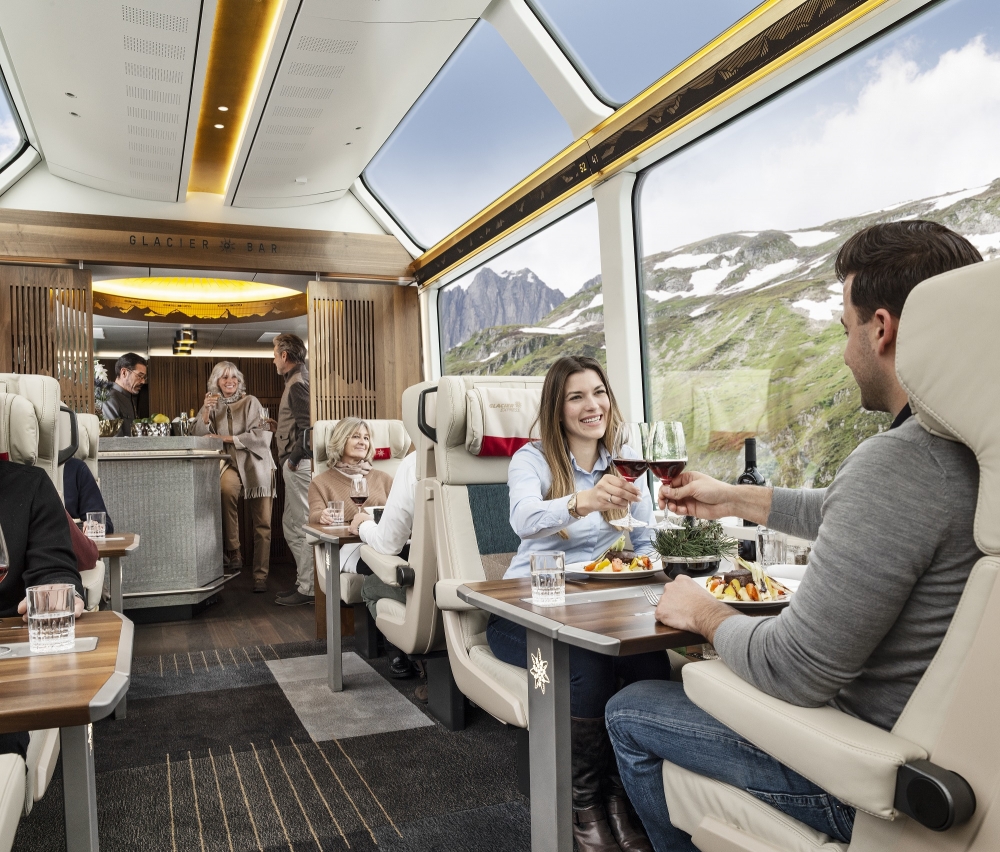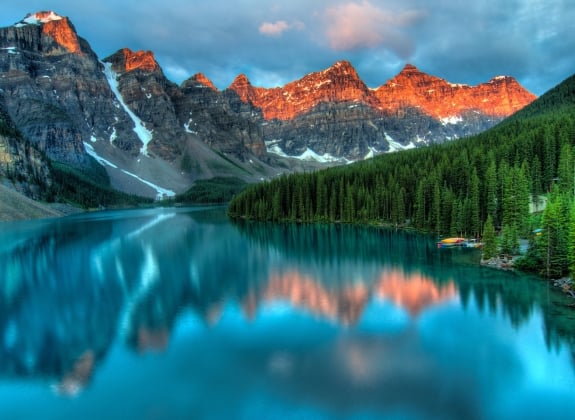Swiss Lakes and Mountains
For any fan of rail travel, or indeed anyone who appreciates spectacular scenery from a comfy train seat, Switzerland is an absolute must. The trains are of very high quality, the service is great and what is more, they run on time to the exact minute - truly a breath of fresh air.
Our Swiss extravaganza began with an evening flight to Zurich from London City airport and after the short flight, we took advantage of the regular trains linking Zurich Airport to its imposing Hauptbahnhof. We spent the night at one of my favourite hotels in our programme – the Schweizerhof Hotel. It’s a traditional family-run hotel opposite the railway station, with some of the highest levels of service I have encountered. On arrival, guests are offered a glass of champagne and butler service for midweek arrivals. The rooms are of a very good size and very comfortable indeed. As we had arrived quite late and had a full itinerary the next day, we decided to avail ourselves of the hotel restaurant that evening. The restaurant manager, Hermann, offered plenty of recommendations and was particularly eager to tempt us with that day’s special of tuna. After an enjoyable meal, we looked forward to the next day’s adventure. We spent the morning in Zurich exploring the winding streets of the old town. Zurich has a plethora of interesting churches and other old buildings, which create a lovely panorama by the lake. It is particularly nice in summer as the locals congregate in the multitude of cafes and bars overlooking the lake. After a quick peek in the shops on the exclusive Bahnhofstrasse we headed back to the station to travel to Lucerne.
For our rail travel in Switzerland we were using rail passes – the best way of travelling around this small country and an option we were determined to make the most of. Lucerne is one of my favourite destinations. Small but perfectly formed, it again benefits from an impressive lakeside setting and has an agreeably relaxing feel. One of the main points of interest is the famous Chapel Bridge, which crosses the lake. It is the oldest wooden bridge in Europe and is decorated with a series of paintings dating from the 17th century, which tell the story of Lucerne’s history. One of these paintings is of the so-called “Wild Man of Lucerne”. This refers to the discovery of bones in the nearby countryside which was believed to belong to an as yet undiscovered breed of prehistoric man – but was later revealed to belong to a woolly mammoth! This leads me neatly on to our Lucerne hotel, the Wilden Mann, a traditional hotel set over seven historic Lucerne townhouses. The hotel has many antiquities from the region, is set close to the lake, and offers two restaurants, fine dining in Wilden Mann Stube, and the Burgerstube serving regional Swiss cuisine. When the restaurant is full of locals you know the food must be good, and this was no exception to that rule.
The following morning we set of for Chur, the oldest city in Switzerland, founded by the Romans in 15 BC. The train journey was very pleasant, with plenty of bubbling streams and chalet-style buildings to be seen as we passed through the Swiss countryside. After checking into our hotel, the ABC Chur, we decided to maximise our use of our rail passes by heading on by train from Chur through the stunning scenery of the Hinterrhein valley to the glamorous town of St Moritz, passing over the famous Landwasser viaduct. St Moritz is a haven for winter sports enthusiasts and hikers alike, but if you have no interest whatsoever in skiing, it’s worth a visit for the stunning scenery en route from Chur and also at the resort itself. Having an interest in languages, I was interested to discover that three languages were spoken there, as well as German and Italian. Some locals also speak Romansch, which used to be widely spoken in the Canton of Graubünden. Sadly, this appears to be on the wane. My attempts at using a few phrases from the back of my Rough Guide to Switzerland were met with seeming incomprehension – though this will be familiar with anyone who has heard my attempts at Italian! After returning to Chur we spent a pleasant evening wandering around the old town.
The next day brought one of the all-time classic rail journeys – the Glacier Express. For reasons of time, we had decided to travel as far as Brig rather than the full 7 and a half hour journey from St Moritz to Zermatt. We were soon relaxing in our seats and taking advantage of the panorama car with its huge windows to admire the scenery as the “slowest express train in the world” slowly climbed up the Oberalp Pass and passed through Andermatt on its way to Brig, where we would be leaving the train. We also took the opportunity of enjoying lunch served at our seats onboard – the perfect accompaniment to a wonderful setting. On arrival in Brig, we took a connecting train to Interlaken via Spiez. We spent two nights in Interlaken staying at the Lindner Grand Beau Rivage hotel in the heart of Interlaken. On arrival, we were again treated to a welcome cocktail in the bar and then decided to make use of the hotel’s pool before heading off to explore Interlaken.
The next morning we began another of the classic rail journeys for which Switzerland is so famous – a trip to the Jungfraujoch, the highest railway station in Europe at the heart of the Bernese Oberland. From Interlaken, we travelled the short journey to Lauterbrunnen, before ascending to the small resort of Kleine Scheidegg, where the cog railway runs through the heart of the mountain up to the Jungfraujoch railway station at 3,454 m (11,332 ft). Before arriving at the Jungfraujoch, it stops for a few minutes at two other stations, where the traveller can have a look through the excavated holes. After the obligatory photos at the “top of Europe” we took a moment to take in the view – fortunately, it was a clear day and we could see for miles. We were even able to step out into the snow briefly – truly a memorable experience. For the return journey, we travelled via the mountain resort of Grindelwald to take in some different scenery – highly recommended.
For our final day in Switzerland, we travelled to Zweisimmen to begin our final “classic rail journey” part of the Golden Pass route through to Montreux. This train runs through vineyards and gardens, passing alpine forests and picturesque mountain villages. On our service, we had a light meal and I was delighted to find a well-stocked cheeseboard with a map of the Golden Pass route – this was the perfect souvenir and now has pride of place in my kitchen! Gradually the station names began to change from German to French as we neared Montreux. Our final night in Switzerland was spent at the Fairmont le Montreux Palace – a luxury hotel with a spectacular setting looking out onto the shores of Lake Geneva. This provided a perfect chance to unwind and relax in comfort before heading back to the UK the following day. After a short trip to Lausanne we took the high-speed TGV Lyria service back to Paris, and then connected with our Eurostar back to London. Switzerland really does provide some spectacular scenery and memorable train journeys which in some cases are inaccessible by any other form of transport – if you want to see how good rail travel can be at its best then this is the country to head for!





